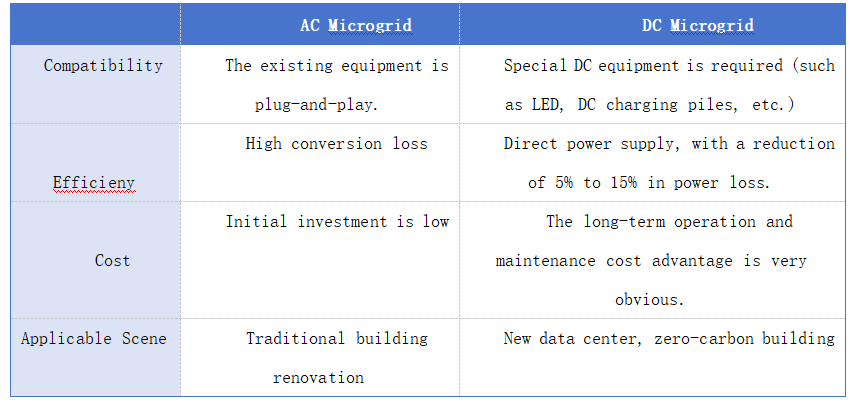2025-06-17
A microgrid is a self-controlled, self-protected, and self-managed autonomous power system. As a complete electrical system, it relies on its own control and management to achieve power balance control, operational optimization, fault detection and protection, and power quality management. Composed of distributed energy resources/micro-sources, energy storage units, loads, and monitoring/protection devices, it features flexible operation modes and dispatchability—capable of switching between grid-connected and islanded (independent) operation. Through coordinated control, it can simultaneously supply both electricity and heat to users, typically connected to lowor medium-voltage distribution networks. Integrating generation, storage, and consumption, it supports hybrid operation in AC, DC, or even high-frequency AC (HFAC).

Core Features
System design, seamless islanding, black start, frequency and voltage control, system balancing, renewable energy optimization.
Core Advantages
Enhanced Reliability and Resilience
● Islanding capability: A key advantage. When the main grid fails due to faults, natural disasters (hurricanes, earthquakes, wildfires), or sabotage, the microgrid can automatically or manually switch to island mode, relying on its distributed energy resources (DERs) to power critical local loads.
● Critical facility support: Ensures uninterrupted power for hospitals, data centers, military bases, emergency shelters, communication facilities, and water treatment plants, safeguarding essential services and business continuity.
● Rapid recovery: After extreme events, microgrids act as "anchor points" for grid restoration, enabling faster local recovery and even assisting main grid restart (black start capability).
Improved Power Quality
● Voltage and frequency stability: Advanced control systems finely regulate local grid parameters, mitigating voltage sags, surges, flicker, and harmonics—ideal for sensitive loads (e.g., precision manufacturing, lab equipment).
● Localized control: Issues are resolved onsite without waiting for remote dispatch centers.
Economic Efficiency and Cost Optimization
● Peak/off-peak arbitrage: Charge storage or run low-cost generators during off-peak hours (e.g., nighttime) and discharge/supply locally during peak pricing (e.g., midday).
● Demand charge reduction: Smooth or shave peak loads to cut fees tied to maximum power demand.
● Lower grid fees: Local generation reduces reliance on transmission/distribution infrastructure.
● Asset optimization: Maximizes utilization of DERs (solar, wind, storage, CHP).
● Market participation: Larger microgrids can join ancillary services (frequency regulation, reserves) or energy markets for revenue.
Renewable Integration and Sustainability
● Local consumption: Efficiently absorbs distributed renewables (solar, wind), minimizing curtailment.
● Higher penetration: Smart controls (with storage/flexible loads) mitigate intermittency, enabling higher renewable shares.
● Carbon reduction: Cuts emissions via clean energy, efficiency (e.g., CHP), and reduced fossil-fuel backup.
Grid Support
● Ancillary services: Provides frequency regulation, voltage support, and spinning reserves to enhance grid stability.
● Congestion relief: In capacity-constrained areas, local generation reduces strain on transmission lines.
● Deferred upgrades: Meets growing demand without costly grid expansions.
Energy Independence
● Reduced grid reliance: Boosts self-sufficiency, insulating users from price spikes or outages.
● Remote electrification: Powers off-grid areas/islands where grid extension is impractical.
Infrastructure Upgrade Deferral
For aging grids or fast-growing loads, microgrids offer an alternative to expensive traditional upgrades.
Tech Breakthrough: AC vs. DC Microgrids?

Future trend: Hybrid AC/DC microgrids will dominate, balancing flexibility and efficiency!
Drivers of Microgrid Development
● Government: National security, policy incentives.
● Utilities: Emissions reduction, sustainability, resilience, new business models.
● Industry: Rising PV/storage competitiveness, demand for rapid response, digital economy’s power-quality needs.
● Healthcare: Patient safety, electronic record protection, backup power.
● Data centers: Storage reduces UPS needs; islanding maintains uptime.
● Higher education: Bulk power contracts, existing generator assets, research continuity, green energy leadership.
Whether you’re a remote community planner, corporate energy manager, or low-carbon innovator, microgrids are a key piece of the energy transition puzzle!
Contact us today for tailored solutions!